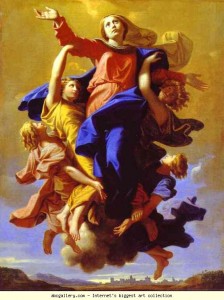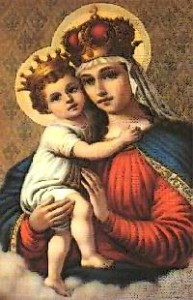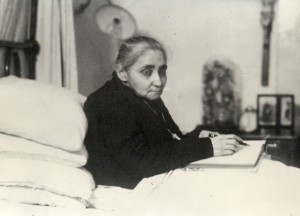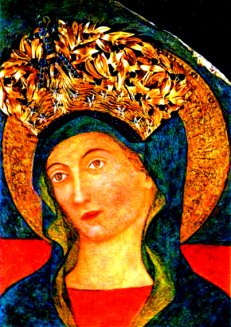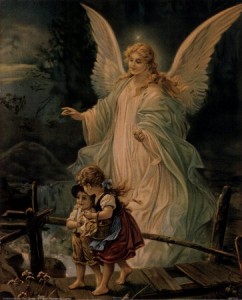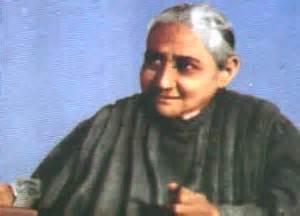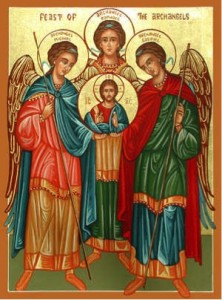
ST THERESE “THE LITTLE FLOWER”
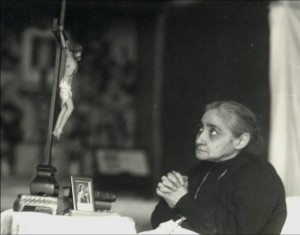
The Servant of God, Luisa Piccarreta the Little Daughter of the Divine Will
(Note the Holy Card of St. Therese at the foot of the Crucifix)
St. Therese of Lisieux was a favored Saint
of the Servant of God, Luisa Piccarreta the Little Daughter of the Divine Will
Apostolic Letter Proclaiming
St. Therese a Doctor of the Church
(excerpts)
Apostolic Letter Proclaims St. Therese Doctor Of The Church
- Apostolic Letter Proclaiming St. Therese a Doctor of the Church (excerpts)Following are excerpts from that Letter:“Among the small, to whom the secrets of the Kingdom have been manifested in a wholly special way, shines Therese of the Child Jesus and the Holy Face, professed nun of the Order of Discalced Carmelites, the centenary of whose entrance into the heavenly homeland is celebrated this year. During her life, Therese discovered ‘new lights, hidden and mysterious meanings’ and received from the divine Master that ‘science of love’ that she manifested with particular originality in her writings.”“The Shepherds of the Church, beginning with my predecessors, the Supreme Pontiffs of this century who proposed her holiness as an example for all, also highlighted the fact that Therese is a teacher of spiritual life through a particular doctrine, simple yet at the same time profound. …This spiritual doctrine has been transmitted to us especially through her autobiography, derived from the three manuscripts which she wrote during the last years of her life and published one year after her death with the title ‘Histoire dune Ame’. … This autobiography, translated along with other writings of hers into nearly fifty languages, made Therese known in all the regions of the world, even outside the Catholic Church. …Therefore it is not surprising that many petitions were presented to the Apostolic See asking that she be endowed with the title of Doctor of the universal Church. …In a special way, as the first centenary of her death approached, …and in light of these facts, I decided to have an attentive study be done to see if the saint of Lisieux, had the prerequisites to be able to receive the title of Doctor of the universal Church.”“Often during Vatican Council II, the Fathers evoked her example and her doctrine. Paul VI… proposed her as a teacher of prayer and theological hope, a model of communion with the Church, entrusting the study of her doctrine to teachers, educators, pastors and theologians themselves. I myself, in various circumstances, have had the joy of referring to the figure and doctrine of this saint, in a special way during the unforgettable visit to Lisieux on June 2, 1980. …The fact that recourse is taken to her doctrine in many documents of the ordinary Magisterium of the Church is a sign of the ecclesial reception of the saint’s teaching, especially when speaking of the contemplative and missionary vocation, of trust in a just and merciful God, of Christian joy, of the vocation of holiness. The presence of her doctrine in the recent ‘Catechism of the Catholic Church’ is a testimonial of this. …Therese possesses a singular universality. …The strength of her message lies in the concrete illustration of how all of Jesus’ promises may find full realization in the believer who knows how to welcome trustingly his own life the saving presence of the Redeemer. All these reasons are a clear testimonial of the current relevance of the doctrine of the saint of Lisieux and of the particular incidence of her message upon the men and women of our time.” About St. Therese, “the little flower”:
- Important Dates in the Life of St. Therese
- Important Dates in the Life of St. Therese
- “Meeting the wishes of a great number of Brothers in the Episcopacy and very many faithful from throughout the world, having heard the opinion of the Congregation for the Causes of Saints and obtained the vote of the Congregation for the Doctrine of the Faith in what regards the eminent doctrine, with certain knowledge and mature deliberation, by the power of full apostolic authority, we declare Saint Therese of the Child Jesus and the Holy Face, virgin, Doctor of the Universal Church. In the name of the Father and of the Son and of the Holy Spirit.”
- “The main source of her spiritual experience and her teaching is the Word of God, in the Old and New Testaments. She herself confesses to this, especially highlighting her passionate love for the Gospel. In her writings more than one thousand Biblical quotes can be counted: more than four hundred from the Old Testament and more than six hundred from the New. …Under the influence of the Spirit she reached for herself and for others a deep knowledge of revelation. …Her doctrine coincides, as already noted, with the teaching of the Church. From childhood, she was educated by family members to participate in prayer and liturgical worship. …Therese nourished herself from her youth with the teaching of the ‘Imitation of Christ’, which, as she herself confessed, she knew almost by heart, …as with the mystical doctrine of Saint John of the Cross, who was her true spiritual teacher. Thus it is not surprising that in the school of these two saints, later declared Doctors of the Church, she too, an excellent disciple, became a Teacher of spiritual life. The spiritual doctrine of Therese of Lisieux contributed to the spreading of the Kingdom of God.”
- “The reception of the example of her life and her evangelical doctrine in our century was rapid, universal and constant. …Pius XI proclaimed her Blessed on April 29, 1923. A short time later, on May 17, 1925, the same Pope, before an immense crowd, canonized her in St. Peter’s Basilica. …Following these acts of recognition, the spiritual irradiation of Therese of the Child Jesus grew in the Church and spread throughout the world. …Her message, often summed up as the so-called ‘little way’, is none other than the Gospel path of holiness for everyone.”
- “This past August 24, at the praying of the Angelus, in the presence of hundreds of bishops and before a multitude of youths from around the globe, gathered in Paris for the 12th World Youth Day. I wished to announce personally the intention to proclaim Therese of the Child Jesus and the Holy Face as Holy Doctor of the universal Church on the occasion of the celebration of World Mission Day.”
- Vatican City, October 19, 1997 (VIS)- Pope John Paul’s Apostolic Letter for the Proclamation of Saint Therese of the Child Jesus and the Holy Face as Doctor of the Church was made public today in French and Italian. It will be available in other languages in coming days.
| BirthdayBaptismDeath of her Mother, Zelie GuerinPauline, her sister, enters Carmel
Our Lady’s Smile; Therese Healing
First Communion
Confirmation
Christmas Conversion
Audience with Pope Leo XIII
Entry into Carmel
Profession of Vows
Death of her Father, Louis Martin
Her Death, Entry into Heaven
Her autobiography “Story of a Soul” is published
Cause of Beatification Introduced at Rome
Beatification
Canonization
Declared Doctor of the Church |
January 2, 1873January 4, 1873August 28, 1877October 2, 1882
May 13, 1883
May 8, 1884
June 14, 1884
December 25, 1886
November 20, 1887
April 9, 1888
September 8, 1890
July 29, 1894
September 30, 1897
September 30, 1898
June 10, 1914
April 29, 1923
May 17, 1925
October 19, 1997 |
Her Parents
The Beatification of Louis and Zelie Martin
On Saturday, July 11, 2008, 7:00P.M., it was announced that Louis and Zelie Martin, parents of St. Therese of Lisieux, will be beatified on Mission Sunday this year.
Louis and Zelie Martin
THE WATCHMAKER – Louis Martin
Louis Martin (1823 – 1894) was a watchmaker by trade, and quite a successful one. He also skillfully managed his wife’s lace business. But, as with so many men, Louis’ life had not turned out at all the way he had planned.
Born into a family of soldiers, Louis spent his early years at various French military posts. He absorbed the sense of order and discipline that army life engenders. His temperament, deeply influenced by the peculiar French connection between the mystical and the military, tended toward things of the spirit.
At twenty-two, young Louis sought to enter religious life at the monastery of the Augustinian Canons of the Great St. Bernard Hospice in the Alps. The blend of courage and charity the monks and their famous dogs manifested in rescuing travelers in Alpine snows appealed powerfully to Louis Martin. Unfortunately, the Abbot insisted the young candidate learn Latin. Louis, whose bravery would have carried him to the heights of the Alps in search of a lost pilgrim, got himself lost among the peaks and valleys of Latin syntax and grammar. His most determined efforts failed. He became ill and dispirited, and abandoned his hopes for the monastic life.
Eventually, Louis settled down in Alencon, a small city in France, and pursued his watchmaking trade. He loved Alencon. It was a quiet place and he was a quiet man. It even had a lovely trout stream nearby, offering him the opportunity to pursue his favorite recreation.
THE LACE MAKER – Zelie Guerin Zelie Guerin
Most famous of Alencon’s thirteen thousand inhabitants were its lace makers. French people greatly admired the skill and talent required to produce the exquisite lace known throughout the nation as Point d’ Alencon.
Zelie Guerin (1831 – 1877) was one of Alencon’s more talented lace makers. Born into a military family, Zelie described her childhood and youth as “dismal.” Her mother and father showed her little affection. As a young lady, she sought unsuccessfully to enter the religious order of the sisters of the Hotel-Dieu. Zelie then learned the Alencon lace-making technique and soon mastered this painstaking craft. Richly talented, creative, eager, and endowed with common sense, she started her own business and became quite successful. Notable as these achievements were, Zelie was yet to reveal the depths of the strength, faith, and courage she possessed.
THE MARTINS
Louis Martin and Zelie Guerin eventually met in Alencon, and on July 13, 1858, Louis, 34, and Zelie, 26, married and began their remarkable voyage through life. Within the next fifteen years, Zelie bore nine children, seven girls and two boys. “We lived only for them,” Zelie wrote; “they were all our happiness.”
The Martins’ delight in their children turned to shock and sorrow as tragedy relentlessly and mercilessly stalked their little ones. Within three years, Zelie’s two baby boys, a five year old girl, and a six-and-a-half week old infant girl all died.
Zelie was left numb with sadness. “I haven’t a penny’s worth of courage,” she lamented. But her faith sustained her through these terrible ordeals. In a letter to her sister-in-law who had lost an infant son, Zelie remembered: “When I closed the eyes of my dear little children and buried them, I felt sorrow through and through….People said to me, ‘It would have been better never to have had them.’ I couldn’t stand such language. My children were not lost forever; life is short and full of miseries, and we shall find our little ones again up above.”
The Martins’ last child was born January 2, 1873. She was weak and frail, and doctors feared for the infant’s life. The family, so used to death, was preparing for yet another blow. Zelie wrote of her three month old girl: “I have no hope of saving her. The poor little thing suffers horribly….It breaks your heart to see her.” But the baby girl proved to be much tougher than anyone realized. She survived the illness. A year later she was a “big baby, browned by the sun.” “The baby,” Zelie noted, “is full of life, giggles a lot, and is sheer joy to everyone.” Death seemed to grant a reprieve to the Martin household. Although suffering had left its mark on mother and father, it was not the scar of bitterness. Louis and Zelie had already found relief and support in their faith.
The series of tragedies had intensified the love of Louis and Zelie Martin for each other. They poured out their affection on their five surviving daughters; Marie, 12, Pauline, 11, Leonie 9, Celine, 3, and their new-born. Louis and Zelie named their new-born; Marie-Francoise-Therese Martin. A century later people would know her as St. Therese, and call her the “Little Flower.”

